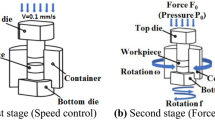Abstract
The hot axial closed die rolling (ACDR) process provides a method to save forming loading for the deformation of titanium alloy discs, but the process parameters differ from the conventional forging. For instance, feed rate of upper die v, angular velocity of lower die ω, feed displacement per revolution of ACDR equipment S, and inclination angle of cone shape γ should be considered simultaneously on the metal plastic flow during hot forming. So, the FE modeling of hot ACDR forming is built reasonably under the SIMUFACT software for dynamic analysis of the hot process. Also, the flow stress curves of TC4 alloy at different temperatures are described by utilizing a Gleeble 3500 machine, and the formula and range of the main parameters are calculated, both of them are included in this model. The laws of metal flow, the strain and temperature field during the process, and, the final, the loading history of ACDR have been explored and analyzed in detail through changing process parameters of v, ω, γ, and S regularly.
Similar content being viewed by others
References
Warchomicka F, Stockinger M, Degischer HP (2006) Quantitative analysis of the microstructure of near β titanium alloy during compression tests. J Mater Process Technol 177:473–477
Poletti C, Warchomicka F, Degischer HP (2010) Local deformation of Ti6Al4V modified 1 wt% B and 0.1 wt% C. Mater Sci Eng A 527:1109–1116
Marczinski HJ (1992) Axial closed die rolling, an economic hot forming method due to high precision and flexibility. J Mater Process Technol 34:495–502
Liu G, Yuan SJ, Wang ZR, Xie T (2000) Finite element model and simulation of rotary forging of a disc. Acta Metall Sin 13:470–475
Liu G, Yuan SJ, Wang ZR, Chi LB (2001) Numerical analysis on rotary forming mechanism of a flange. J Mater Sci Technol 17:129–130
Wang GC, Zhao GQ (1999) A three dimensional rigid plastic FEM analysis of rotary forging deformation of a ring workpiece. J Mater Process Technol 95:112–115
Wang GC, Zhao GQ (2002) Simulation and analysis of rotary forging a ring work-piece using finite element method. Finite Elem Anal Des 38:1151–1164
Samolyk G (2013) Investigation of the cold orbital forging process of an AlMgSi alloy bevel gear. J Mater Process Technol 213:1692–1702
Han XH, Hua L (2009) 3D FE modeling of cold rotary forging of a ring workpiece. J Mater Process Technol 209:5353–5362
Han XH, Hua L (2009) 3D FE modeling of cold rotary forging of a cylinder workpiece. J Mater Des 30:2133–2142
Han XH, Hua L (2011) Prediction of contact pressure, slip distance and wear in cold rotary forging using finite element methods. Tribol Int 44:1742–1753
Han XH, Hua L (2014) Investigation on contact parameters in cold rotary forging using a 3D FE method. Int J Adv Manuf Technol 214:2402–2416
Montoya I, Santos MT, Pérez I, González B, Puigjaner JF (2008) Kinematic and sensitivity analysis of rotary forging process by means of a simulation model. Int J Mater Form 1:383–386
Mangas Á, Santos M (2012) Microstructural behaviour in rotary forging of Inconel 718. Key Eng Mater 504–506:169–174
Mangas Á, Santos M (2013) Sensitivity analysis to optimise the microstructural properties of an Inconel 718 component manufactured by rotary forging. Key Eng Mater 554–557:234–247
Yu ZQ, Ma Q, LIN ZQ (2008) Simulation and analysis of microstructure evolution of IN718 in rotary forgings by FEM. J Shanghai Jiaotong Univ (Sci) 13:721–726
Pan Y, Liu J, Liu D, Wu BW, Sun EJ (2010) 3D numerical simulation of axial closed dies rolling process for disk forging. Forging Stamping Technol 35(4):61–66 (in Chinese)
Jiao Y, Liu D, Liu J, Sun EJ (2011) Optimization of process parameters for ACDR process of disk forging. Casting forging weld 40(13):65–68 (in Chinese)
Hu ZH (2006) China materials engineering canon. Chemical Industry Press (in Chinese)
Hambli R (2007) Metal flow prediction during sheet-metal punching process using the finite element method. Int J Adv Manuf Technol 33:1106–1113
Li F, Lin JF, Yuan SJ, Liu XJ (2009) Effect of inner cone punch on metal flow in extrusion process. Int J Adv Manuf Technol 42:489–496
Zhang CS, Zhao GQ, Chen H, Guan YJ, Kou FJ (2012) Numerical simulation and metal flow analysis of hot extrusion process for a complex hollow aluminum profile. Int J Adv Manuf Technol 60:101–110
Author information
Authors and Affiliations
Corresponding author
Rights and permissions
About this article
Cite this article
Zheng, Y., Liu, D., Yang, Y. et al. Investigation on metal flow during the hot axial closed die rolling process for titanium alloy discs. Int J Adv Manuf Technol 87, 2445–2458 (2016). https://doi.org/10.1007/s00170-016-8650-0
Received:
Accepted:
Published:
Issue Date:
DOI: https://doi.org/10.1007/s00170-016-8650-0




